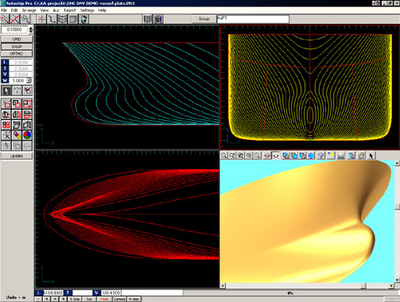Autoship

Hull Design & Surface Modelling Program
Autoship is a powerful hull design/surface modeling program that combines the graphical user interface of Windows with the dexterity of NURBS (Non-Uniform Rational B-Spline) mathematics, the high-end CAD standard for surface modeling. Autoship enables the user to create any hull shape from a racing yacht to a super tanker quickly and efficiently. Autoship software is used worldwide by thousands of boat designers, naval architects and design offices, with single stand-alone or networked software licences
Autoship Key Features
3D Viewing
The user-friendly interface enables the designer to work either in 4 views simultaneously (profile, plan, body and rotatable 3-D) or one of the views singly merely at the click of a button. The 4 views may be dynamically resized at any time and may be individually panned. There are 10 levels of zoom/unzoom
Object Based Hierarchy
Autoship building blocks consist of Points, Curves, Surfaces, Polyobjects and Groups. Groups are collections of objects, including other groups, which may be scaled, rotated, mirrored, offset, and multiply instanced to allow very complex structures from a minimal number of objects. Changes to an object are propagated through the groups containing it
Curves
Curves may be free or embedded on surfaces or other curves. There are several methods available to create a curve: specifying endpoints, sketching, forming an arc or rectangle, projection onto a surface, lofting through points, by intersecting surfaces, as offset from another curve, as foil shape, as row or column of a surface or by geodesic offset from another embedded curve. Surface edges may be attached to a curve or another surface.
Curvature Display
There are curvature displays for both curves and surfaces. A "porcupine quill" display is available for both curves and surfaces, and a color-mapped rendering shows mean curvature or gaussian curvature of a surface.
Surfaces
Create by specifying dimensions, by rotating a curve about an axis, by extruding a curve along a vector, by sweeping one curve along another, by ruling between two curves, by multi-conic development (developable surface) between two curves, by offset from another surface, by blending between surfaces, by skinning through a set of curves or by joining two surfaces.
Engineering Accuracy
Displays the tree structure of a project and gives quick access to object properties and operations.
Navigator
The user can specify a tolerance for output and curves and surfaces are automatically refined to meet or exceed that tolerance. This enables the user to choose high accuracy for NC cutting or to specify a larger tolerance value during design to save on computation.
Hydrostatics/Resistance
Autoship comes with built-in Quick Hydrostatics, with equilibrium calculation, plus fast links to Autohydro for full hydrostatic analyses and to Autopower for resistance and powering prediction.